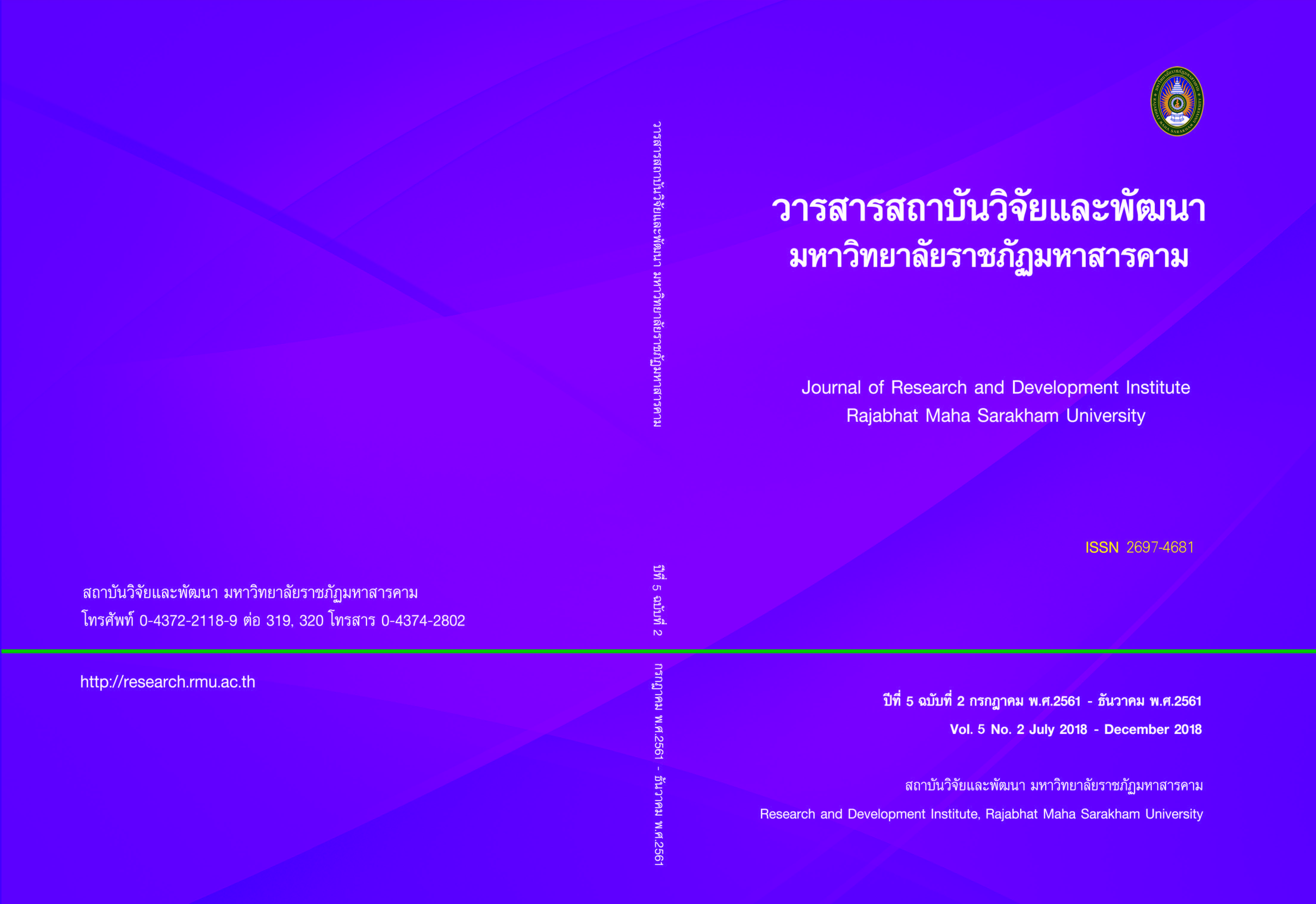Teacher Leadership Factor Affecting Professional Learning Community in School under the Office of Secondary Educational Service Area 26
Keywords:
Teacher leadership, Professional learning communityAbstract
leadership factor under the office of secondary educational service area 26, (2) the level of professional learning community in school under the office of secondary educational service area 26, (3) the relationship between teacher leadership factor and professional learning community in school, and (4) teacher leadership factor affecting professional learning community in school. Population of this research were 1,907 people, consist of administrator and teacher in school under the office of secondary educational service area 26. Sampling group remained 320 people with stratified random sampling. Research instrument was five-rating scale. Data were analyzed using mean, percentage, standard deviation, person product moment correlation and stepwise multiple regression analysis by using computer program for figuring out. The findings were as follows : (1) Overview of teacher leadership factor under the office of secondary educational service area 26 at a “high” level of performance. The highest performance was found with professional teacher while the lowest one was transformational leadership. (2) Overview of professional learning community in school under the office of secondary educational service area 26 at a “highest” level of performance. The highest performance was found with share leadership while lowest was personal learning and development. (3) The relationship between teacher leadership factor and professional learning community in school under the office of secondary educational service area 26 were positively correlated with a statistical significance at the.01 level. (4) Teacher leadership factor affecting professional learning community in school under the office of secondary educational service area 26 was found with 1) professional teacher 2) role model in teaching 3) self and colleagues’ development 4) transformational leadership. The multiple correlation coefficients were 0.839 and 70.30 percentage with statistically significant level of.01.
References
Anutsara Suwanwong. (2017). “Components of Teacher Leadership for Strengthening Professional Growth in High Competitive School” Panyapiwat Journal, 9 (Special edition) : July 2017. [In Thai]
Apharat Ratchapat. (2011). Alternative : A development of teacher leadership indicators for basic education school. Ph.D. Thesis (Educational Administration) Khonkaen University. [In Thai]
Barth, R.S. (2001). Teacher leader. Phi Delta Kappan, 82 (4), 8-12.
Cosenza, M.N. (2010). The impact of professional development school on teacher leadership. California : California Lutheran University.
Hairon Salleh. (2016). Instructional leadership in teachers leading professional learning communities : An Asian Singapore perspective. Singapore : Technological University.
Hord, S.M. (1997). Professional learning communities of continuous inquiry and Improvement. Austin : Southwest Education Development Laboratory.
Jatupum Ketchatturat. (2012). Educational Research : Theory into Practice. Khon Kaen : Educational Measurement and Evaluation Program, Faculty of Education, Khonkaen University.
Krejcie, R. V. & Morgan, D. W. (1970). Determining sample size for research activities. Educational and Psychological Measurement, 30 (3) : 607-610.
Moller, G., & Pankake, A. (2006). Lead with me : A principal’s guide to teacher leadership. New York : Eye on Education.
Murphy, J. (2005). Connecting teacher-leadership to school improvement. Thousand Oaks, CA : Corwin Press.
Office of the Basic Education Commission. (2010). Teacher Competency Assessment Guide of Office of the Basic Education Commission 2010. Bangkok : Ministry of Education. [In Thai]
Office of the Basic Education Commission. (2015). Policies of Office of the Basic Education Commission, fiscal year 2015. Bangkok : Agricultural Cooperative of Thailand Limitedition. [In Thai]
Office of the Council of State. (2013). The Teachers Council of Thailand Regulations Regarding Professional Standards. Government Gazette. Volume 130, Special Episode 130D. : 65 71. (2013, 4 March). [In Thai]
Office of the Education Council. (2017). National Education Plan 2560– 2579. Bangkok : Sweet Chili Graphic Co., Ltd.. [In Thai]
Pichet Ketwong. (2013). Proposition of Guidelines for Building Professional Learning Communities in Schools under the Office of Pathumthani Primary Educational Service Area 2. Master’s Thesis, M. Edition. (Educational Administration). Phranakhon Si Ayutthaya : Phranakhon Si Ayutthaya Rajabhat University. [In Thai]
Pimpan Dachakupt. (2015). Learning Management in the 21st Century. 2nd edition.,Bangkok : Printing of Chulalongkorn University. [In Thai]
Prime Minister’s Office. (2016). Draft national strategy 20 years 2017–2036. [Online] http : //www.thaigov.go.th/uploads/document/66/2017/01/pdf/20year-may59.pdf [1 May 2018] [In Thai]
Secondary Educational Service Area Office 26. (2018). Vision, Mission. [Online] http : //www.web.ses26.go.th [1 May 2018] [In Thai]
Senge : M. (1990). The fifth discipline : The art and practice of the learning organization. Doubleday, New York, NY : MCB UP Ltd.
Spillane, J. P. (2006). Distributed leadership. San Francisco : Jossey Bass.
Suwat Inthawong, Nopporn Kosira and Chatree Nakakul. (2008). “The Relationship between Change Agent Leadership and Teamwork as Perceived byTeachers in Secondary Schools under Nongkhai Educational Service Area Office”. The Golden Teak (Humanity and Social Science Journal), 14 (2) : July-December. [In Thai]
Thunyaporn Bunraksa. (2010). Factors affecting the learning community of Schools under the local administrative organization in Loei Province. Master of Education Thesis (Educational Administration), Loei Rajabhat University. [In Thai]
Tisana Khammani. (2008). Teaching Science : Knowledge for Effective Learning Process Management. 7th Edition., Bangkok : Printing of Chulalongkorn University. [In Thai]
Verbiest, E. (2008). Sustainable school development : Professional learning communities. Netherland : Fontys University.
Woralak Chookamnerd, Ekkarin Sungtong and Chawalit Kerdtip. (2014). “A Model of a Professional Learning Community of Teachers Toward 21st Century Learning of Schools in Thailand”. Hatyai Journal, 12 (2) Jul - Dec 2014. page : 123-134 [In Thai]
York-Bar, J., & Duck, K. (2004). What do we know about teacher leadership? Findings from two decades of scholarship. Education in Organization, 74 (3). 255-346.
Downloads
Published
How to Cite
Issue
Section
License
Articles that are published are copyrighted by the authors of the articles







